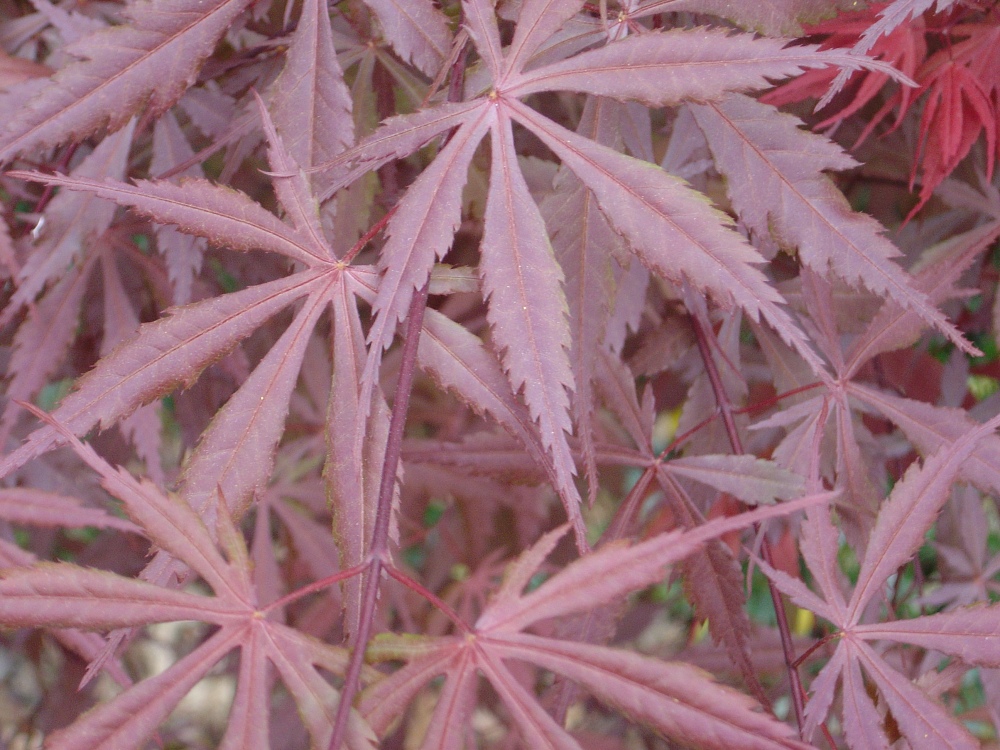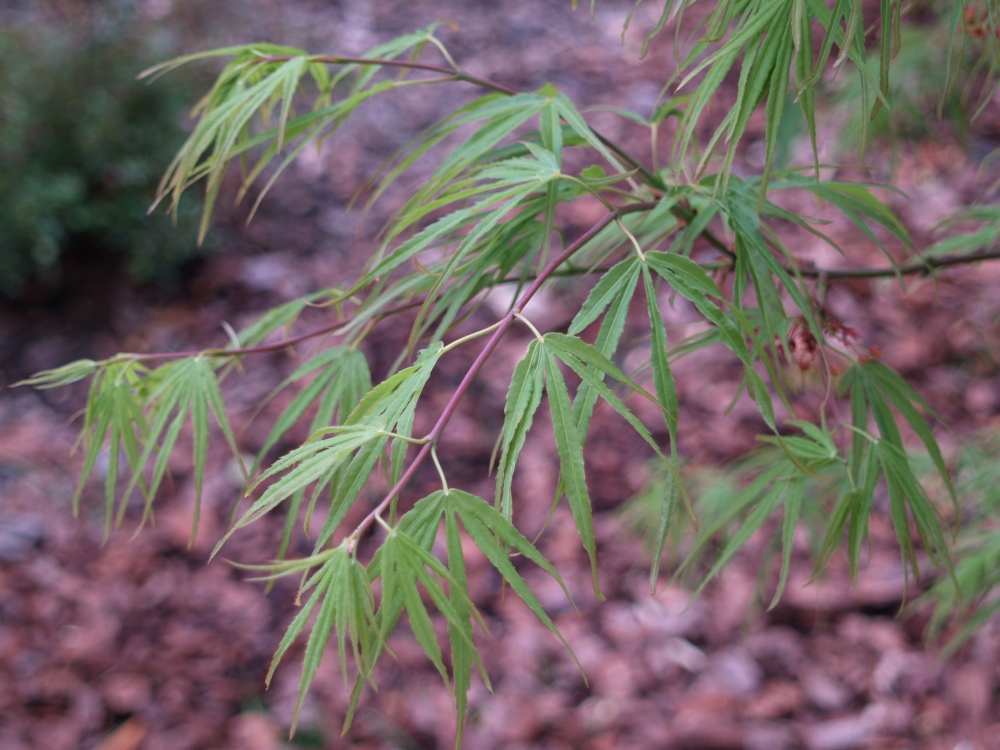Twenty-two years ago the garden was begun in a simple fashion, with a few shrubs, two white flowering dogwoods, and two Japanese maples planted in the front of the house. A rudimentary bluestone path was constructed through the mud from the gravel drive to the front porch. The maples were common cultivars, ‘Crimson Queen’ (Acer palmatum dissectum ‘Crimson Queen’, below), a red laceleaf with pendulous branching, and ‘Bloodgood’ (A. palmatum ‘Bloodgood’), a vigorous red leafed upright. Today, these remain the most popular selections in garden centers, and they have grown to become the visual anchors of my front garden.
The dogwoods were planted inside the front walk with the idea that as they grew visitors would walk under their branches to reach the front door. But, the slope from the street down to the house funneled rain water so that this area stayed too damp for the dogwoods. One died and the other was transplanted to a drier location outside the walk. To replace the dogwoods, two upright growing, green laceleaf ‘Seriyu’ Japanese maples (A. palmatum dissectum ‘Seriyu’, below) were selected, again with the idea that they would be pruned to form a canopy over the walk.
Today, the ‘Seriyu’ maples have grown to nearly twenty feet tall, and a bit wider. Good horticultural sense would dictate that the trees are planted far too close to the house, and indeed the branches destroy the window screens as they sway in the breeze. On a rainy day the long branches are weighed down so that visitors must stoop low to avoid being soaked, but on a dry day you walk in filtered sunlight beneath branches with finely dissected leaves just above your head. Precisely as I intended.
After the ‘Seriyu’ maples were planted the chronology becomes a bit foggier, but needless to say the numbers increased steadily until today there are twenty-one Japanese maples in the garden, not including the dozens (perhaps hundreds) of seedlings that pop up everywhere. Three maples were planted a few weeks ago despite my wife’s objection that there were too many already. I tell her that there’s plenty of space if only we could remove the small patch of lawn at the rear of the garden, and why not? The kids are grown and gone, and the only use for the property is my planting and wandering about.
Most of the maples in my garden could not be considered exotic, and few are rare, though many cultivars are not commonly found in gardens or for sale by any other than specialty growers. This is not a grand collection. I’m certain that more extensive collections can easily be found, with more splendid trees that are displayed more prominently. In this garden the trees are not labeled or tagged, and I regularly forget the names of several of the less common maples, just as I often can’t recall one coneflower or toad lily from another.
Before going further it should be said that despite the reputation they seem to have, Japanese maples are easy to grow, and many are much more vigorous than people suspect. I regularly see weeping dissectum types that have spread to obstruct walkways and patios, and in fact I had to move the large Crimson Queen maple ten years ago as it began to encroach on my front walk. I was too lazy to dig the rootball properly, so halfway through I wrapped a chain around the roots, hooked it to our car, and dragged the tree out of its hole. This is the appropriate time to warn “not to try this at home”, but the maple lived and today grows like a weed as it encroaches on our driveway. This is not a dainty tree, and I’ve found that maples will tolerate blazing sun or a bit more shade than you expect, bone dry, or damp so long as the ground dries occasionally. 
If there is a problem with Japanese maples, I’ve found that the wrong cultivar is too often planted where there is too little space. A boxwood or laurel can be hacked back to fit when it borders a walk or patio too closely, but try this with a Japanese maple and its form is ruined. So, we must first decide which maple is appropriate, and then give it adequate space. For most weeping cultivars (such as ‘Crimson Queen’) an area of ten by ten feet will barely accommodate its mature growth. Leave five or six feet between your maple and the nearest shrub or evergreen and fill the space with perennials such as liriope that can be moved as it grows wider.
When I return in a couple days for the second chapter we will explore the different types of maples by foliage type, by growth habit, and by leaf color until I’ve posted every photo and told every story. Perhaps you will find a tree that you will treasure in your garden for the next twenty years.
I love your Jap. maple stories. Could you give us more info on growing condtions so that we (me especially) may join in your love for these beautiful maples. I have 4, but long for more, just am not sure I have the right conditions.
I fear that I’m getting a little long winded on the topic. I’m not looking to drag you through reading a book, but I’ll try to fit a bit more cultural information in the next chapter. With four, you’re on the road to being an addict.
Great article. I realize now that my Crimson Queen is going to swamp everything next to it eventually. I’ll worry about that when it happens. 😉
If you are unable to move a Japanese maple that is too close to a walk or patio you can prune select branches. Follow the outer branches on the side that will eventually be a problem to the inside to prune them as close to the main trunk as possible. If branches are cut out in this manner the form of the tree will look much more natural, and it will take much longer before it poses a problem.
I love reading about your garden. Do you ever have a open house for your customers?
I have not, but if I thought more than a couple people would care to see it I’d be happy to have them visit. Perhaps next spring I’ll see if I can see if anyone’s interested.
My 7 year old crimson Queen “Queenie” has not started blooming yet this year and I am worried she is dying. It is April 14 in Tallahasse Fl. Am I being anxious this year to see her bloom or is this normal. She also seems to have more dead looking wood this year.
Some dead wood is typical on Japanese maples, but the concern that I would have is whether there were enough cooling days through the winter this year in Tallahassee. I assume that temperatures were much warmer than average for you this winter, just like much of the rest of the country. Deciduous plants have a number of days of cold weather that they require to go dormant then to leaf in the spring. If there are not enough cold days to meet that plant’s requirements they will leaf out late, sometimes very late, even though the wood and buds are perfectly alive.
The number of cold days has never been a problem for Virginia gardens, so I don’t have a good answer. I’d recommend visiting a local garden center to ask their opinion, because if that’s the problem they’re probably seeing it in other gardens. I’ve heard some good things about Tallahassee Nursery from some nursery growers in your area, so that would be a good place to start. Also, I know that Florida has an excellent horticultural extension through the University of Florida. I’ve seen their crapemyrtle trial gardens in Quincy.